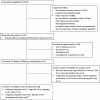Cumulative sucrose exposure for repeated procedural pain in preterm neonates and neurodevelopment at 18 months of corrected age: a prospective observational longitudinal study
- PMID: 38986541
- PMCID: PMC11284924
- DOI: 10.1136/bmjpo-2024-002604
Cumulative sucrose exposure for repeated procedural pain in preterm neonates and neurodevelopment at 18 months of corrected age: a prospective observational longitudinal study
Abstract
Introduction: Oral sucrose is repeatedly administered to neonates in the neonatal intensive care unit (NICU) to treat pain from commonly performed procedures; however, there is limited evidence on its long-term cumulative effect on neurodevelopment. We examined the association between total sucrose volumes administered to preterm neonates for pain mitigation in the NICU and their neurodevelopment at 18 months of corrected age (CA).
Methods: A prospective longitudinal single-arm observational study that enrolled hospitalised preterm neonates <32 weeks of gestational age at birth and <10 days of life was conducted in four level III NICUs in Canada. Neonates received 0.1 mL of 24% sucrose 2 min prior to all commonly performed painful procedures during their NICU stay. Neurodevelopment was assessed at 18 months of CA using the Bayley Scales of Infant and Toddler Development, Third Edition (Bayley-III). Multiple neonatal and maternal factors known to affect development were adjusted for in the generalised linear model analysis.
Results: 172 preterm neonates were enrolled and 118 were included in the analysis at 18 months of CA. The total mean sucrose volume administered/neonate/NICU stay was 5.96 (±5.6) mL, and the mean Bayley-III composite scores were: cognitive 91 (±17), language 86 (±18) and motor 88 (±18). There was no association between Bayley-III scores and the total sucrose volume: cognitive (p=0.57), language (p=0.42) and motor (p=0.70).
Conclusion: Cumulative sucrose exposure for repeated procedural pain in preterm neonates was neither associated with a delay in neurodevelopment nor neuroprotective effects at 18 months of CA. If sucrose is used, we suggest the minimally effective dose combined with other non-pharmacological interventions with demonstrated effectiveness such as skin-to-skin contact, non-nutritive sucking, facilitated tucking and swaddling.
Trial registration number: NCT02725814.
Keywords: Neonatology; Neurodevelopment; Pain.
© Author(s) (or their employer(s)) 2024. Re-use permitted under CC BY-NC. No commercial re-use. See rights and permissions. Published by BMJ.
Conflict of interest statement
Competing interests: None declared.
Figures

References
Publication types
MeSH terms
Substances
Associated data
LinkOut - more resources
Full Text Sources
Medical
